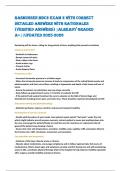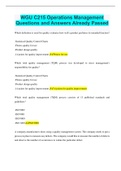RASMUSSEN MDC 2 EXAM 2 WITH CORRECT DETAILED ANSWERS WITH RATIONALES (VERIFIED ANSWERS) |ALREADY GRADED A+||UPDATED 2025 -2026 Remaining still for hours, sitting for long periods of time, anything that prevents circulation Clients at risk for DVT - Handrails in bathrooms - Ramps instead of stairs - Wear rubber sole shoes - Avoid scatter rugs - Prevent clutter - Avoid slippery floors Prevention of falls - Increased intraocular pressure in a hollow organ. - When the intraocular pressure increase it leads to compression of the retinal blood vessels and photoreceptors and their nerve fibers resulting in hypoxemia and death of the tissue and loss of vision. - Assure the patient can administer own eye drops correctly - Keep follow -up appointments every 1 -3 months to evaluate the IOP. - If the patient had s urgical treatment be sure to educate on the S&S of hemorrhage and detachment including severe pain, and vision loss. These should be reported immediately to HCP. Glaucoma teaching and pathophysiology - Maintain perfusion, improve comfort, and prevent impai red mobility Prioritization of care for a fracture - Handle with the palms of your hands, have patient report painful "hot spots" under the cast which might indicate area of pressure necrosis, instruct patient to never put anything down into the cast, encourage the patient/family to smell the area for must iness or unpleasant odor (if ignored the patient may develop a fever). - Assess skin color and temperature, sensation, mobility, pain, capillary refill, and pulses distal to the fracture site. CMS - circulation, movement, and sensation. Cast education and a ssessment - Infection of the bone. May be acute or chronic. - Educate about medications, encourage compliance and to follow regimen (take full course of medications), inform about signs and symptoms, provide comfort during rest and with positioning, assist in ADL, coordinate physical therapy while in the hospital to help improve mobility especially after surgery, provide mobility assistance devices. Osteomyelitis prevention and treatment methods - Gonioscopy is used when elevation intraocular pressure is di agnosed to determine if the glaucoma is open -angle or closed -angle. It allows the visualization of the angle where the iris meets the cornea. Test to determine open vs closed angle glaucoma - CMS: circulation, mobility, sensation. Assess skin color, temper ature, sensation, mobility, pain, capillary refill, and pulses. Neurovascular assessment - P: Palliative, Q: Quality, R: Region, S: Scale, T: Time Pain assessment - The great toe shifts laterally, and the first metatarsal head of the great toe enlarges - Pain especially when shoes are worn - Treatment: custom made shoes or surgery Bunions (hallux valgus) - Perform passive ROM exercises for patients who are immobile - Turn and reposition every 2 hours - Assess for skin redness Priority assessments for immobi le patients - A continuous ringing or noise perception in the ears. Tinnitus Also called farsightedness. Occurs when the eye does not refract light enough. As a result, images actually converge behind the retina. Distant vision is normal, but near vision i s poor. Hyperopia - Decreases all muscle strengths including the lungs, increases secretion (aspiration pneumonia is a risk), decrease ventilation capacity in response to exercise, respiratory depth decreases affecting ventilation, air passage blockage can lead to atelectasis (collapse of air sacs or alveoli). Immobility consequences on the respiratory system Paralysis of one side of the body Hemiplegia Paralysis of the lower portion of the trunk and both legs Paraplegia Partial or incomplete paralysis Pare sis Paralysis of all four extremities. quadriplegia - Used for partial weight -bearing, both feet; faster, but less support than a 4 -point gait. Two -point gait Non -weight bearing; faster than a 4 -point gait; can use with a walker Three -point gait Used for partial weight -bearing, both feet; patient must shift weight constantly. Four -point gait - Step 1: Be in an upright position with head slightly tilted back - Step 2: Don procedure gloves - Step 3: Cleanse the edges of the eyelid from the inner can thus to the outer canthus. - Step 4: Gently rest the dominant hand on the forehead. - Step 5: With the nondominant hand, pull the lower lid down to expose the conjunctival sac. - Step 6: Position the eye dropper about 1.5 to 2.0 cm above the patient's eye. Ask the patient to look up, and drop the prescribed number of drops into the conjunctival sac. Do not let the dropper touch the eye. - Step 7: Ask the patient to gently close their eyes as it helps distribute the medicine. - Step 8: If the medication has systemic effects, press gently against the side of the nose for 1 to 2 minutes to close the lacrimal ducts. Eye drop administration education - Avoid standing in one position for a long period of time - Do not lock your knee when standing - Keep core tight - Do not bend forward at the waist or neck - Sit at a comfortable height when at the desk - Do not wear high -heeled or platform shoes for a long period of time - Do not slump when sitting - Sit close to your work - Use back support - Sit with your feet fl at on the floor and knees below your hips - Sleep on a firm mattress Proper body mechanics (body alignment, coordination, balance, joint mobility) 30 degrees Semi -Fowler's 45-90 degrees High -Fowler's Patient leans forward to help with respiration. Used in SOB. Orthopneic Side -lying with legs in line





